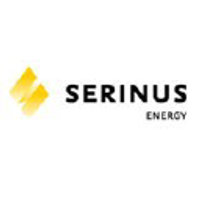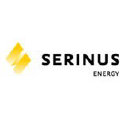
Serinus Energy PLC
LSE:SENX


| US |

|
Johnson & Johnson
NYSE:JNJ
|
Pharmaceuticals
|
| US |

|
Berkshire Hathaway Inc
NYSE:BRK.A
|
Financial Services
|
| US |

|
Bank of America Corp
NYSE:BAC
|
Banking
|
| US |

|
Mastercard Inc
NYSE:MA
|
Technology
|
| US |

|
UnitedHealth Group Inc
NYSE:UNH
|
Health Care
|
| US |

|
Exxon Mobil Corp
NYSE:XOM
|
Energy
|
| US |

|
Pfizer Inc
NYSE:PFE
|
Pharmaceuticals
|
| US |

|
Palantir Technologies Inc
NYSE:PLTR
|
Technology
|
| US |

|
Nike Inc
NYSE:NKE
|
Textiles, Apparel & Luxury Goods
|
| US |

|
Visa Inc
NYSE:V
|
Technology
|
| CN |

|
Alibaba Group Holding Ltd
NYSE:BABA
|
Retail
|
| US |

|
JPMorgan Chase & Co
NYSE:JPM
|
Banking
|
| US |

|
Coca-Cola Co
NYSE:KO
|
Beverages
|
| US |

|
Walmart Inc
NYSE:WMT
|
Retail
|
| US |

|
Verizon Communications Inc
NYSE:VZ
|
Telecommunication
|
| US |

|
Chevron Corp
NYSE:CVX
|
Energy
|
Utilize notes to systematically review your investment decisions. By reflecting on past outcomes, you can discern effective strategies and identify those that underperformed. This continuous feedback loop enables you to adapt and refine your approach, optimizing for future success.
Each note serves as a learning point, offering insights into your decision-making processes. Over time, you'll accumulate a personalized database of knowledge, enhancing your ability to make informed decisions quickly and effectively.
With a comprehensive record of your investment history at your fingertips, you can compare current opportunities against past experiences. This not only bolsters your confidence but also ensures that each decision is grounded in a well-documented rationale.
Do you really want to delete this note?
This action cannot be undone.

| 52 Week Range |
2.4
3.35
|
| Price Target |
|
We'll email you a reminder when the closing price reaches GBX.
Choose the stock you wish to monitor with a price alert.

|
Johnson & Johnson
NYSE:JNJ
|
US |

|
Berkshire Hathaway Inc
NYSE:BRK.A
|
US |

|
Bank of America Corp
NYSE:BAC
|
US |

|
Mastercard Inc
NYSE:MA
|
US |

|
UnitedHealth Group Inc
NYSE:UNH
|
US |

|
Exxon Mobil Corp
NYSE:XOM
|
US |

|
Pfizer Inc
NYSE:PFE
|
US |

|
Palantir Technologies Inc
NYSE:PLTR
|
US |

|
Nike Inc
NYSE:NKE
|
US |

|
Visa Inc
NYSE:V
|
US |

|
Alibaba Group Holding Ltd
NYSE:BABA
|
CN |

|
JPMorgan Chase & Co
NYSE:JPM
|
US |

|
Coca-Cola Co
NYSE:KO
|
US |

|
Walmart Inc
NYSE:WMT
|
US |

|
Verizon Communications Inc
NYSE:VZ
|
US |

|
Chevron Corp
NYSE:CVX
|
US |
This alert will be permanently deleted.
Serinus Energy PLC
Serinus Energy Plc engages in the exploration, development, and production of oil and gas. The Company, along with its subsidiaries, is principally engaged in the exploration and development of oil and gas properties in Tunisia and Romania. The Satu Mare Concession of approximately 729,000 gross acres is one of the exploration blocks in Romania, lying on a prolific oil and gas trend in the Eastern Pannonian Basin. Its four areas of interest for exploration and development consists of Berveni AOI, Santau-Madaras AOI, and Babesti AOI. The firm holds five Tunisia concessions that comprises a diverse portfolio of development and exploration assets. The company produces oil and gas in Tunisia through its various working interests in two of the five Oil and Gas Concessions. The firm's concessions consists of Sabria, Chouech Es Saida, Ech Chouech, Sanrhar and Zinnia.

Serinus Energy Plc engages in the exploration, development, and production of oil and gas. The Company, along with its subsidiaries, is principally engaged in the exploration and development of oil and gas properties in Tunisia and Romania. The Satu Mare Concession of approximately 729,000 gross acres is one of the exploration blocks in Romania, lying on a prolific oil and gas trend in the Eastern Pannonian Basin. Its four areas of interest for exploration and development consists of Berveni AOI, Santau-Madaras AOI, and Babesti AOI. The firm holds five Tunisia concessions that comprises a diverse portfolio of development and exploration assets. The company produces oil and gas in Tunisia through its various working interests in two of the five Oil and Gas Concessions. The firm's concessions consists of Sabria, Chouech Es Saida, Ech Chouech, Sanrhar and Zinnia.
This earnings call has not been analyzed yet.
If you’d like us to analyze this earnings call, click the "Request Earnings Call Analysis" button below.





























